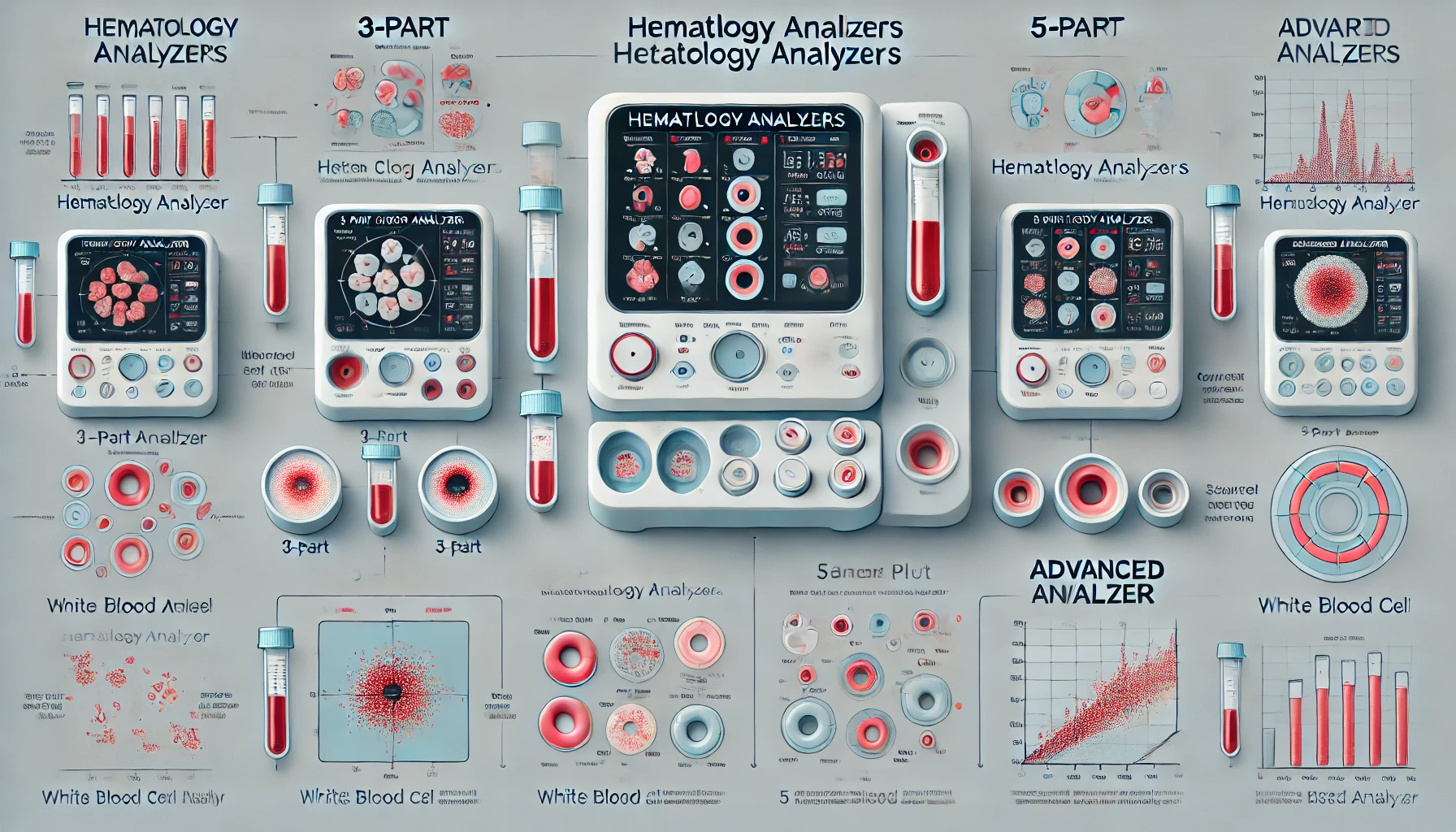
Hematology analyzers are critical diagnostic tools used in laboratories to evaluate blood samples and detect abnormalities. They vary based on their ability to analyze different types of white blood cells (WBCs) and other components of blood. Below is a detailed breakdown of the differences between 3-part, 5-part, 6-part, and 7-part hematology analyzers.
1. 3-Part Hematology Analyzers
Overview: 3-part analyzers classify white blood cells into three broad categories:
- Lymphocytes
- Monocytes
- Granulocytes (a combined group of neutrophils, eosinophils, and basophils)
Key Features:
- Suitable for basic diagnostics and small laboratories.
- Measures parameters like red blood cell (RBC) count, hemoglobin, platelet count, and total WBC count.
- Limited precision in WBC differentiation due to grouped granulocytes.
Advantages:
- Affordable and cost-effective.
- Requires less maintenance.
- Simpler operation and quicker results.
Disadvantages:
- Inability to differentiate between individual granulocytes (neutrophils, eosinophils, basophils).
- Limited use in specialized or advanced diagnostic requirements.
Use Cases:
- Small clinics and routine health check-ups.
2. 5-Part Hematology Analyzers
Overview: 5-part analyzers provide a detailed classification of WBCs into:
- Neutrophils
- Lymphocytes
- Monocytes
- Eosinophils
- Basophils
Key Features:
- Offers a complete blood count (CBC) with advanced WBC differentiation.
- Measures over 20 parameters, including Mean Corpuscular Volume (MCV), Red Cell Distribution Width (RDW), and Mean Platelet Volume (MPV).
Advantages:
- High accuracy in diagnosing diseases like infections, allergies, and leukemias.
- Advanced diagnostics with better clinical insights.
Disadvantages:
- Higher cost compared to 3-part analyzers.
- Requires more maintenance and technical expertise.
Use Cases:
- Medium to large diagnostic laboratories and hospitals.
3. 6-Part Hematology Analyzers
Overview: 6-part analyzers expand the functionality of 5-part analyzers by adding immature granulocyte (IG) count to the differential count.
Key Features:
- Includes IG count, which is critical for diagnosing severe infections, bone marrow disorders, and sepsis.
- Maintains all functionalities of 5-part analyzers.
Advantages:
- Enhanced diagnostic capability for critical conditions.
- Useful in monitoring treatments like chemotherapy.
Disadvantages:
- Higher cost and complexity compared to 5-part analyzers.
- Requires advanced operator training.
Use Cases:
- Advanced diagnostic centers and oncology departments.
4. 7-Part Hematology Analyzers
Overview: 7-part analyzers go beyond traditional hematology analysis by incorporating additional diagnostic markers such as reticulocyte count or advanced parameters like nucleated RBCs (NRBCs).
Key Features:
- Combines all functionalities of 6-part analyzers with extra specialized parameters.
- Useful for in-depth analysis of blood-related disorders.
Advantages:
- Superior diagnostic power for complex and rare conditions.
- Provides more precise insights for personalized medicine.
Disadvantages:
- Premium pricing and high maintenance requirements.
- May not be necessary for general laboratory use.
Use Cases:
- Specialized research laboratories and advanced hospitals handling rare blood disorders.
Comparison Table
| Feature | 3-Part | 5-Part | 6-Part | 7-Part |
|---|---|---|---|---|
| WBC Differentiation | Lymphocytes, Monocytes, Granulocytes | Neutrophils, Lymphocytes, Monocytes, Eosinophils, Basophils | Adds Immature Granulocytes (IG) | Adds parameters like NRBC or reticulocytes |
| Parameters | Basic CBC | CBC + Detailed WBC | CBC + WBC + IG | CBC + WBC + Advanced Parameters |
| Accuracy | Moderate | High | Higher | Superior |
| Cost | Low | Moderate | High | Very High |
| Maintenance | Low | Moderate | Moderate to High | High |
| Use Cases | Routine Testing | Diagnostic Labs | Critical Care, Oncology | Research and Specialized Labs |
Conclusion
Choosing the right hematology analyzer depends on the laboratory’s size, budget, and diagnostic requirements.
- 3-part analyzers are cost-effective and ideal for basic testing.
- 5-part analyzers suit medium to large labs, offering detailed WBC analysis.
- 6-part analyzers are perfect for diagnosing critical conditions.
- 7-part analyzers provide advanced diagnostic insights for specialized cases.
For laboratories in Bangladesh seeking reliable solutions, Sysmex, Beckman Coulter, Erba, Horiba, Dymind and Mindray analyzers are popular choices offering models across all these categories. Understanding your lab's needs will help ensure a wise investment in hematology equipment.





